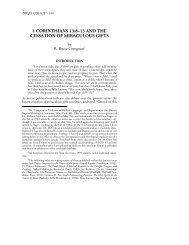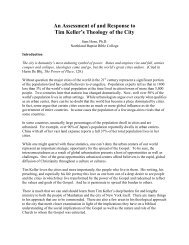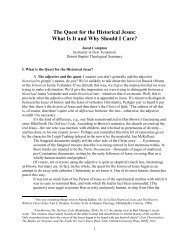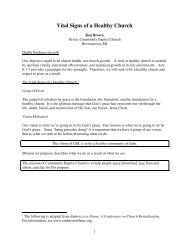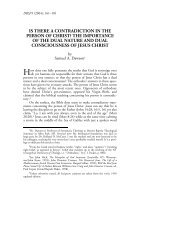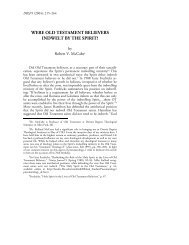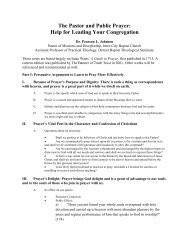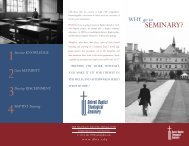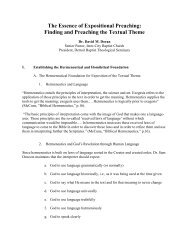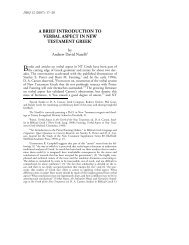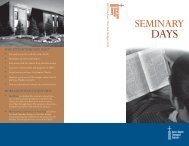Dispensational Sanctification: A Misnomer - Detroit Baptist ...
Dispensational Sanctification: A Misnomer - Detroit Baptist ...
Dispensational Sanctification: A Misnomer - Detroit Baptist ...
Create successful ePaper yourself
Turn your PDF publications into a flip-book with our unique Google optimized e-Paper software.
<strong>Dispensational</strong> <strong>Sanctification</strong> 103<br />
Pentecostal <strong>Sanctification</strong><br />
Flowing out of the Wesleyan holiness movement of the nineteenth<br />
century, Pentecostal sanctification maintains that a post-conversion<br />
experience sought by the believer is a necessity. 40 Rather than seeking<br />
for entire sanctification, Pentecostals seek for baptism in the Spirit. 41<br />
The result of this Spirit baptism is empowerment for service (rather<br />
than the Wesleyan concept of perfection in love). 42 Stanley Horton<br />
summarizes Pentecostal sanctification teaching by explaining that baptism<br />
in the Spirit is an event subsequent to and distinct from justification;<br />
it empowers the individual for various types of Christian service;<br />
and it is a blessing that should be sought by all believers. 43<br />
Again, we see the necessity for a post-conversion experience. We<br />
also note that the link between justification and sanctification is only a<br />
possibility based upon a believer’s decision to seek baptism in the<br />
Spirit.<br />
Keswick <strong>Sanctification</strong><br />
Like Pentecostal sanctification Keswick theology shares many<br />
similarities with the Wesleyan holiness movement. 44 One example of<br />
this similarity is that it views sanctification and justification as two<br />
40<br />
Charles Edwin Jones, Perfectionist Persuasion: The Holiness Movement and<br />
American Methodism, 1867–1936, ATLA Monograph Series, vol. 5 (Metuchen, NJ:<br />
Scarecrow Press, 1974), pp. 4–5.<br />
41 Timothy L. Smith, “The Doctrine of the Sanctifying Spirit: Charles G. Finney’s<br />
Synthesis of Wesleyan and Covenant Theology,” Wesleyan Theological Journal 13<br />
(Spring 1978): 100–103, and Frederick Dale Bruner, A Theology of the Holy Spirit: The<br />
Pentecostal Experience and the New Testament Witness (Grand Rapids: Eerdmans,<br />
1970), p. 38.<br />
42<br />
Stanley M. Horton, “The Pentecostal Perspective,” in Five Views of <strong>Sanctification</strong><br />
(Grand Rapids: Zondervan, 1987), p. 130. Although he was not a Pentecostal, R.<br />
A. Torrey (The Baptism with the Holy Spirit, 6 th ed. [London: James Nisbet & Co.,<br />
1905], p. 13) also argued for this meaning of Spirit baptism. This was a common<br />
theme among most American revivalists at the turn of the century. Also see Douglas<br />
Robinson, “The ‘Ordo Salutis’ and Charismatic Movement,” Churchman 97 (1983):<br />
p. 233.<br />
43<br />
Horton, “The Pentecostal Perspective,” pp. 128–34. Howard M. Ervin (Conversion-Initiation<br />
and the Baptism in the Holy Spirit. A Critique of James D. G. Dunn’s<br />
Baptism in the Holy Spirit [Peabody, MA: Hendrickson, 1984], p. vii) confirms the<br />
first two of these points.<br />
44 W. Ralph Thompson, “An Appraisal of the Keswick and Wesleyan Contemporary<br />
Positions,” Wesleyan Theological Journal 1 (Spring 1966): pp. 11–20; and Everett<br />
L. Cattell, “An Appraisal of the Keswick and Wesleyan Contemporary Positions,” in<br />
Insights into Holiness, ed. Kenneth Geiger (Kansas City, MO: Beacon Hill Press,<br />
1962), pp. 264–65.



